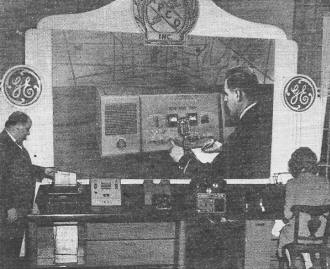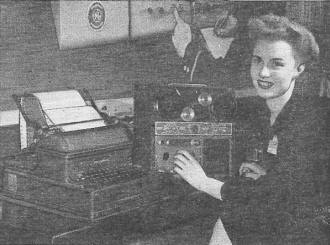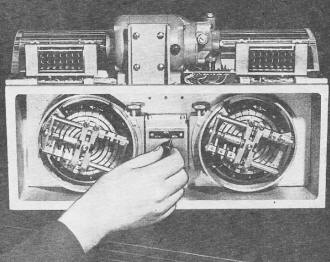|
August 1945 Radio-Craft
 [Table
of Contents] [Table
of Contents]
Wax nostalgic about and learn from the history of early electronics.
See articles from Radio-Craft,
published 1929 - 1953. All copyrights are hereby acknowledged.
|
Although not specifically
stated, some of the technology reported in this August 1945 issue of
Radio-Craft magazine was not so long before classified technology developed
during World War II. The Radiotype system of wireless teletype developed by
General Electric was an early attempt to provide a mobile means of sending and
receiving hard copy messages. It was a rather complex scheme that used a
typewriter to drive a tape punching apparatus, which was fed into a radio
transmitter to send coded tones (as opposed to CW pulses) for a receiver to then
decipher and drive an
Electromatic
typewriter. The demonstration used a police car to carry remote equipment. In
related news, RCA's wireless 488 word-per-minute (wpm) telegraph multiplexer
using time division multiplexing (TDM) Also
featured was the FCC's decision to move the commercial broadcast FM band from
54-88 MHz up to 88-106 MHz (now up to 108 MHz, but then the upper 2 MHz was
reserved for teletype). Technology was on the move.
Items Interesting to the Technician
 Tone signals and Radiotype
apparatus as a means of combatting crime were demonstrated at the recent visit
of the New York State chapter of the Associated Police Communications Officers
to Schenectady, G-E reported last month. Tone signals and Radiotype
apparatus as a means of combatting crime were demonstrated at the recent visit
of the New York State chapter of the Associated Police Communications Officers
to Schenectady, G-E reported last month.
The Radiotype equipment uses a standard Electromatic typewriter applied to
communications apparatus. In full automatic operation, copy is typed on a sending
typewriter which perforates a tape. This tape is "read" by an automatic transmitting
head which keys the electronic communications unit, sending out a tone signal.
This tone signal is sent over a radio circuit, the same as a voice signal. At
the receiving end the tone is fed into an electronic unit which selects the
proper keys on the receiving typewriter which prints the message. The G-E boys
caught the tones on a magnetic recorder, later running the wire off again to
actuate the receiving apparatus which typed out the message. Transmission by
Radiotype over regular F11 circuits was also demonstrated to the visiting police
communications men. At the Helderberg mountain site of G.E., 50 police officers
were shown a one-way demonstration of Radiotype when messages were sent from
the company's plant, about 0.13 miles away. This operated on 35.46 megacycles.
The engineers had voice communication between the mountain and plant by standard
FM emergency equipment and used the same equipment to transmit the Radio type.

Equipment used in the G-E demonstrations.

Making Radiotype tapes.
While no attempt was made to multiplex voice and Radiotype over the same
carrier in this demonstration, the engineers explained that this has already
been done without interference on either channel.
Voice communication was also demonstrated on a frequency of 161.775 megacycles
using experimental mobile FM equipment. (FM voice communication by police radio
systems have heretofore been in operation on frequencies between 30-40 megacycles
and between 116-119 megacycles.) This new frequency (161.775 megacycles) is
in that part of the radio spectrum which the Federal Communications Commission
has proposed for new emergency communication uses by police and fire departments.
A car was equipped with 4-watt experimental FM radio apparatus which enabled
the engineers in the car to talk from various parts of the Capital District
to engineers and their guests at the G.E. transmitter site in the Helderberg
Mountains, The car transmitter was heard at various distances up to 50 miles
away. The channel from the Helderbergs to the car was conventional 30-40 megacycles
equipment; the talk-back was on 161.775 megacycles.
Maintenance of present radio receivers will take precedence
over production of new sets in the allotment of new radio tubes, the War Production
Board stated last month. When new tubes are made in quantity, strict priority
will be given to repairmen for the purpose of keeping existing radios in service,
over manufacturers who would use them in new receivers.
WPB officials suggested that authorization of 4,000,000 civilian radio tubes
per month. might soon be forthcoming, but were silent as to just how soon that
might be.
Army spokesmen reported that cancellations of military tube orders were being
made in small numbers, and stated that the Army's present stockpile was now
being re-examined and might possibly reveal stocks which would make further
cancellations possible.
According to WPB estimates, it will take an average of 1 1/2 tubes per set
to put the "silent 9%" of America's receivers back into action. Thus the first
million tubes would restore 660,000 sets, where the same number would spread
over only 200,000 five-tube, and a smaller number of larger new receivers.
FM Allocations were fixed between 88 and 106 megacycles
by the Federal Communications Commission on June 27. Twenty of these channels,
between 88 and 92 megacycles, are reserved for non-commercial educational FM
stations.
Six channels are assigned to television, one between 44 and 50 megacycles,
three between 54 and 72 and two between 76 and 88. Amateurs will occupy the
frequencies between 50 and 54 megacycles allotted to them by the Commission
early in the year. This will continue the old "5-meter band" which formerly
ran from 56 to 60 megacycles.
The remaining space in the spectrum between 44 and 108 megacycles was allotted
as follows: facsimile, 106-108; non-Government fixed and mobile services, 42-44
and 72-76 megacycles. This closes the allocation of frequencies between 25 to
30,000 megacycles.
The FCC believes the present decision, moving FM "upstairs" from the band
between 42 and 50 megacycles, will make it freer from interference and other
shortcomings than it would be in any other portion of the spectrum.
Recognizing that considerable opposition was advanced by manufacturers and
engineers skeptical as to the advantages of the higher-frequency band, the Commission
stated that it "has a duty to consider the long-range effects of its action
as well as the effects during the months immediately ahead, and it doesn't propose
to provide an inferior FM service during the decades to come merely because
of the transitory advantages which may be urged for an inferior type of service."
Television will appear as an executive force in the postwar
world, holding large companies together and permitting a closer-knit management
than is now possible, reported International Business Machines last month, announcing
its intention of providing television relay facilities on a common carrier basis
for business use.
With the help of television, a chain store with branches in all parts of
the country could maintain a daily or hourly checkup on receipts, inventories,
sales, etc. All the bookkeeping could be handled in a central office. Such organizations
as railroads, with their widely-scattered equipment and centralized organization,
would also benefit greatly by the use of television.
Dealers interviewed by McCall's Magazine expressed opinions
differing in many instances from those of the nation's customers, according
to a survey whose results were announced last month.
Better radio furniture for the postwar radio is the first requisite for sales,
according to the 376 dealers interviewed. The three most popular models will
be the table radio, the console combination and the table combination, not necessarily
in that order. Dealers saw no future for the console radio without phonograph,
and suggested that manufacturers would be well-advised to discontinue the model.
Among console radios, the type in which the record player pulls out was the
favorite, with 253 votes out of 329, the remainder of the 376 dealers not voting.
The "lift top" was next, with only 40 votes, while the tilting front type and
the combination in which the top must be lifted to get at either radio or phonograph
split only 36 votes between them.
The question of brand loyalty raised in consumer surveys also appeared among
dealers. While the majority stated that they expected to carry the same brand
as pre-war, most of them had reservations. It was pointed out that in radio,
far more than in other electrical appliances, new names had a habit of springing
up and dominating the market for a few years, before giving way to another or
fading out entirely.
On only one thing the dealers were in agreement - the assured future of FM.

The multiplex distributor used by RCA to send over eight
channels simultaneously.
Multiplex telegraphy, long familiar on wire circuits, will
now speed up transmission by radio while cutting errors to the zero level, according
to a report released last month by the Radio Corporation of America.
By means of specially designed equipment which employs what is known in the
industry as "time division multiplex telegraph" principles, the equipment can
handle 488 words per minute inward and outward simultaneously, corresponding
to eight channels each way with an individual channel speed of 61 words per
minute. The equipment also permits operation of four or two channels instead
of eight" channels, when desired.
All eight channels may be utilized for two-way communication with one distant
station. Alternatively, they may be set up in such a way that four channels
with a total capacity of 244 words per minute can be operated in both directions
simultaneously between two different stations, with automatic retransmission
of one or more of the channels to a third station.
Moreover, printing mechanism incorporated in the system accomplishes the
feat of making the circuit virtually error-proof, despite its high speed. Let
any letter be mutilated or garbled in transmission and a warning bell rings
under the receiving printer. At the same instant, in lieu of the mutilated character,
a maltese cross appears to mark the exact spot of the error and facilitate correction.
In other words, no error can get through directly to the message blank.
Another bell, of noticeably different pitch, is operated by means of a switch
similar to a telephone dial. With it the receiving operator can pass a number
of stock phrases for service instruction to the other end of the circuit, thereby
saving channel operating time.
The multiplex distributor used by RCA to transmit over eight channels simultaneously.
The printer is completely automatic and, in conjunction with the multiplex
mechanism, the system functions with a minimum of circuit time. Each incoming
letter is comprised of three marking (signal) impulses, plus four spacing (no
signal) impulses. The name - seven unit - stems from this fact. Automatic counting
features incorporated in the receiving printer check the arriving impulses,
and if the marking impulses vary from three, the warning bell sounds and the
maltese cross emerges to report an error.
Vital to the system is a newly perfected method for keeping the receiving
channelling devices in exact step with the distant transmitter and the signal
elements being sent through the air.
Improvement in time division multiplex operation has been achieved through
the inclusion in the same mechanism of the devices that perform the basic channeling
function and also of the face plates which pass the signal elements from or
to the seven-unit printing equipment in the proper sequence and at the right
time intervals for transmission and reception.
In physical appearance, transmitting and receiving equipment used in the
new RCA system is at but slight variance from conventional radiotelegraph apparatus,
in spite of its amazing performance. At each terminal of the circuit are two
cabinet racks 84 inches in height, each containing a multiplex distributor,
visible about half-way between top and bottom. One rack is primarily for receiving
and the other primarily for transmission. Other equipment includes printers,
keyboard perforators and tape transmitters.
The amazing performance of the new circuit leads the engineers to predict
wide use for eight-channel equipment in handling postwar traffic.
Posted
|












